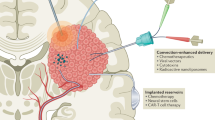Abstract
Glioblastoma multiforme (GBM) is an incurable malignant brain tumor, usually fatal within 1 year of diagnosis. Using a syngeneic rat 9L gliosarcoma model, we have developed a novel drug delivery method in which naked plasmid DNA is selectively targeted to brain tumors via intra-arterial injection. Using a plasmid encoding the antiangiogenic endostatin, transgene expression can be detected in tumor cells in vivo, and therapeutic efficacy is observed. Administration of this plasmid resulted in an 80% tumor volume reduction 1 week after treatment and enhanced survival time by up to 47%. Treated tumors exhibited a 40% decrease in the number of tumor vessels; ultrastructural analysis of remaining tumor vessels demonstrated a number of changes including markedly narrowed or collapsed lumens. We conclude that intra-arterial injection of plasmids selectively targets therapeutic genes to CNS neoplasms. This method of gene therapy holds promise for the treatment of these highly malignant brain tumors.
This is a preview of subscription content, access via your institution
Access options
Subscribe to this journal
Receive 12 print issues and online access
$259.00 per year
only $21.58 per issue
Buy this article
- Purchase on Springer Link
- Instant access to full article PDF
Prices may be subject to local taxes which are calculated during checkout





Similar content being viewed by others
References
Kramm CM et al. Gene therapy for brain tumors. Brain Pathol 1995; 5: 345–381.
Lam PY, Breakefield XO . Potential of gene therapy for brain tumors. Hum Mol Genet 2001; 10: 777–787.
Boehm T, Folkman J, Browder T, O'Reilly MS . Antiangiogenic therapy of experimental cancer does not induce acquired drug resistance. Nature 1997; 390: 404–407.
Folkman J . Angiogenesis in cancer, vascular, rheumatoid and other disease. Nat Med 1995; 1: 27–31.
Carmeliet P, Jain RK . Angiogenesis in cancer and other diseases. Nature 2000; 407: 249–257.
O'Reilly MS et al. Endostatin: an endogenous inhibitor of angiogenesis and tumor growth. Cell 1997; 88: 277–285.
Blezinger P et al. Systemic inhibition of tumor growth and tumor metastases by intramuscular administration of the endostatin gene. Nat Biotechnol 1999; 17: 343–348.
Chen QR, Kumar D, Stass SA, Mixson AJ . Liposomes complexed to plasmids encoding angiostatin and endostatin inhibit breast cancer in nude mice. Cancer Research 1999; 59: 3308–3312.
Read TA et al. Local endostatin treatment of gliomas administered by microencapsulated producer cells. Nat Biotechnol 2001; 19: 29–34.
Barnett FH et al. Selective delivery of herpes virus vectors to experimental brain tumors using RMP-7. Cancer Gene Ther 1999; 6: 14–20.
Rainov NG et al. Intra-arterial virus and nonvirus vector-mediated gene transfer to experimental rat brain tumors. Front Radiat Ther Oncol 1999; 33: 227–240.
Rainov NG et al. Intraarterial delivery of adenovirus vectors and liposome–DNA complexes to experimental brain neoplasms. Hum Gene Ther 1999; 10: 311–318.
Kuo CJ et al. Oligomerization-dependent regulation of motility and morphogenesis by the collagen XVIII NC1/endostatin domain. J Cell Biol 2001; 152: 1233–1246.
Musso O et al. Tumor hepatocytes and basement membrane-producing cells specifically express two different forms of the endostatin precursor, collagen XVIII, in human liver cancers. Hepatology 2001; 33: 868–876.
Sauter BV et al. Adenovirus-mediated gene transfer of endostatin in vivo results in high level of transgene expression and inhibition of tumor growth and metastases. Proc Natl Acad Sci USA 2000; 97: 4802–4807.
Kroll RA et al. Improving drug delivery to intracerebral tumor and surrounding brain in a rodent model: a comparison of osmotic versus bradykinin modification of the blood–brain and/or blood–tumor barriers. Neurosurgery 1998; 43: 879–886; discussion 886–879.
Rainov NG et al. Selective uptake of viral and monocrystalline particles delivered intra-arterially to experimental brain neoplasms. Hum Gene Ther 1995; 6: 1543–1552.
Loser P et al. Advances in the development of non-human viral DNA-vectors for gene delivery. Curr Gene Ther 2002; 2: 161–171.
Bloch W et al. The angiogenesis inhibitor endostatin impairs blood vessel maturation during wound healing. FASEB J 2000; 14: 2373–2376.
Zagzag D et al. Vascular apoptosis and involution in gliomas precede neovascularization: a novel concept for glioma growth and angiogenesis. Labor Invest 2000; 80: 837–849.
Holash J, Wiegand SJ, Yancopoulos GD . New model of tumor angiogenesis: dynamic balance between vessel regression and growth mediated by angiopoietins and VEGF. Oncogene 1999; 18: 5356–5362.
Chan PT, Weller RO . Factors influencing tumour cell and vascular proliferation in glioblastoma. Neuropathol Appl Neurobiol 2002; 28: 155–156.
Ram Z et al. Therapy of malignant brain tumors by intratumoral implantation of retroviral vector-producing cells. Nat Med 1997; 3: 1354–1361.
Acknowledgements
This work was supported by grants to MF from the National Eye Institute R24EY14174 and the Robert Mealey Program for the Study of Macular Degenerations. FB is a Skaggs Scholar in Clinical Science and receives grant support from the Skaggs Program. We are grateful to numerous members of the Friedlander Laboratory for assistance in various aspects of this project and to the staff and veterinarians of the LARC at TSRI for their excellent assistance.
Author information
Authors and Affiliations
Rights and permissions
About this article
Cite this article
Barnett, F., Scharer-Schuksz, M., Wood, M. et al. Intra-arterial delivery of endostatin gene to brain tumors prolongs survival and alters tumor vessel ultrastructure. Gene Ther 11, 1283–1289 (2004). https://doi.org/10.1038/sj.gt.3302287
Received:
Accepted:
Published:
Issue Date:
DOI: https://doi.org/10.1038/sj.gt.3302287
Keywords
This article is cited by
-
Angiotensin II increases gene expression after selective intra-arterial adenovirus delivery in a rabbit model assessed using in vivo SSTR2-based reporter imaging
EJNMMI Research (2016)
-
E10A, an adenovirus-carrying endostatin gene, dramatically increased the tumor drug concentration of metronomic chemotherapy with low-dose cisplatin in a xenograft mouse model for head and neck squamous-cell carcinoma
Cancer Gene Therapy (2012)
-
Intra-arterial Targeted Islet-specific Expression of Sirt1 Protects β Cells From Streptozotocin-induced Apoptosis in Mice
Molecular Therapy (2011)
-
Hydrodynamic Gene Delivery and Its Applications in Pharmaceutical Research
Pharmaceutical Research (2011)



